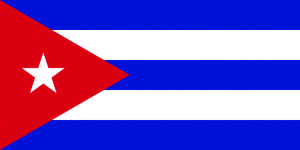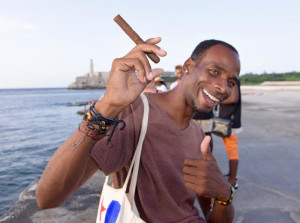 – by Kelly Hedgecock
– by Kelly Hedgecock
Kelly Hedgecock ,25, grew up in Walnut Creek, is the daughter of our own Diablo Gazette’s Bookends columnist Jill Hedgecock and works at a San Francisco ad agency. She loves to travel.

With relations continuing to thaw with Cuba, Americans now have a new destination opportunity for that curious traveler and adventurer, which I am one. When it comes to discussing Cuba as an American, there’s a lot of hearsay. “Don’t you have to travel with a private tour group? I heard you can’t use bank cards in Cuba. Be careful, it’s dangerous there! I heard the food is terrible!“ My boyfriend, Paul, and I wanted to see for ourselves.
After some preliminary research, we learned Americans have twelve reasons for traveling to Cuba, but that general tourism is not one of them. Our incentive for going was to have people-to-people interactions, stay with Cuban families, and visit museums.
 We flew to Havana from Cancun. We felt uneasy at the Cancun airport. When do we need to buy our visa? Were they going to question our motives? As we scrambled to fill out the necessary paperwork, we noticed families bringing comforters, air conditioners, even cases of Corona with them – all commodities in a country with a US trade embargo.
We flew to Havana from Cancun. We felt uneasy at the Cancun airport. When do we need to buy our visa? Were they going to question our motives? As we scrambled to fill out the necessary paperwork, we noticed families bringing comforters, air conditioners, even cases of Corona with them – all commodities in a country with a US trade embargo.
In the end, we had no problems entering Cuba. The only question customs asked was “Have you been to Africa in the last six months?” However, we waited two hours for our luggage. Finally, it came through and we embarked to our first accommodation – a “casas particulares.”
“Casas particulares” or “private houses” are the preferred method of room and board in Cuba. Many local families rent out extra rooms in their homes, charging tourists $30 USD per night; a fortune for Cubans considering this amount is equivalent to monthly salaries of some doctors. In addition, meals cooked by the hosts were the some of the best food we had in Cuba. A typical meal would include fish, chicken or pork paired with white rice, black beans, plantains, avocado and cucumber. Breakfast was often a treat with a fresh mango or papaya smoothie, eggs, cheese, and bread with butter and jam.

 As for the money situation, tourists who exchange their money will receive “CUCs” (pronounced ‘kooks’) or Cuban Convertible Pesos. One CUC is worth one USD. Locals use the regular national peso, which is worth much less. Unsuspecting tourists are consistently overcharged for everything from taxi rides to meals to tours. We quickly learned the proper prices from savvy tourists and kind casas particulares hosts. The major issue with private businesses charging tourists premium prices is that it creates a huge economic divide between Cubans in the tourist industry and resentment from the rest of society.
As for the money situation, tourists who exchange their money will receive “CUCs” (pronounced ‘kooks’) or Cuban Convertible Pesos. One CUC is worth one USD. Locals use the regular national peso, which is worth much less. Unsuspecting tourists are consistently overcharged for everything from taxi rides to meals to tours. We quickly learned the proper prices from savvy tourists and kind casas particulares hosts. The major issue with private businesses charging tourists premium prices is that it creates a huge economic divide between Cubans in the tourist industry and resentment from the rest of society.

We had many interactions with locals. Most encounters started with conversation asking where we were from and ending with them wanting something from us. By the way, fair warning: If someone tells you their friend works at a cigar factory and can get you the best cigars for a great price, do not go with them. If you  agree to get a drink or meal with a local, expect to pay for theirs as well. Don’t get me wrong, the Cubans were good people. They never pressed too hard, were always kind and charismatic. Cubans respect the law and fear of getting caught with drugs and guns keeps the crime rate low. We felt very safe throughout the trip.
agree to get a drink or meal with a local, expect to pay for theirs as well. Don’t get me wrong, the Cubans were good people. They never pressed too hard, were always kind and charismatic. Cubans respect the law and fear of getting caught with drugs and guns keeps the crime rate low. We felt very safe throughout the trip.
 Exploring Old Havana, walking along the Malecón, riding in a vintage 60’s convertible, eating traditional Cuban food on the balcony of an apartment-turned-restaurant, riding horses in Viñales Valley, tasting Cuban rum, seeing a cabaret are all experiences we will cherish forever. Cuba is a country rich in culture with the most loud and proud people I have ever met. If you are an adventurous traveler, speak a little Spanish, and want to immerse yourself in a country where it feels like you traveled fifteen years back in time, a trip to Cuba is for you.
Exploring Old Havana, walking along the Malecón, riding in a vintage 60’s convertible, eating traditional Cuban food on the balcony of an apartment-turned-restaurant, riding horses in Viñales Valley, tasting Cuban rum, seeing a cabaret are all experiences we will cherish forever. Cuba is a country rich in culture with the most loud and proud people I have ever met. If you are an adventurous traveler, speak a little Spanish, and want to immerse yourself in a country where it feels like you traveled fifteen years back in time, a trip to Cuba is for you.
.

